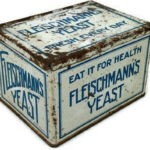Campbell’s Soup had free advice
for idealized mothers and housewives
1950s advertising campaign for Campbell’s Soup Company went a long way to advance the advice that everybody
should eat soup every day with the meal, or as a meal
Free advice, it is often said, is usually worth exactly what you pay for it but Campbell’s Soup Company ignored that maxim in a 1950s advertising campaign featuring Anne Marshall, Director, Home Economics at Campbell’s. It’s a notable campaign.
The campaign—in print and on film—promoted soup as the heart of a meal, as a party dish, as a family favorite, as babies first solid food. The messages in these 1950s advertisements had direct advice for married women presumably striving to be better mothers and wives. There’s not a single advertisement directed to single women or women who work or men who cook. Not even teens merited a message. Judge for yourself!
Soup is just natural in winter, apparently, when “all the folks come home cold at noon” to a “warm-you-fast lunch of Vegetable Soup (14 vegetables in a good beef stock), brown bread and cream cheese, ham and celery rolls. What a really good lunch!”
Sunday is described as mother’s “night off” and so the family chooses soup as a main dish because “it can be prepared in just four minutes.”

The Schools Days advertisement makes the claim that children who get nourishing, substantial meals are the ones who frequently stand out because it helps in their work and in their playtime energy. “You can give your boys and girls the right lunch—and so easily!” Mother is then cautioned to “make sure your children are eating right, whether at home or at school with a lunch like this: a hearty soup…their favorite sandwiches…a simple dessert…and milk. It’s an ideal meal!”

A woman’s place, it is implied, was in the kitchen but “who wants to be tied to the kitchen” in summer—so this advertisement suggests even wilting appetites will “perk up…since soup takes only 4 minutes to prepare, you’re in and out of the kitchen in practically no time.” The menu suggestions are Bean with Bacon soup, buttered toast and jam, sugared strawberries, and milk. Or, Vegetable soup with hot dogs and trimmings, banana outmeal cookies, and milk. Or, Cream of Celery soup with egg and pickle salad, fresh cherry sundae, and milk.

Meal planning was required if a mother or wife was to rise to success and Tomato soup “helps you and your meal planning in so many, many ways.” This advertisement asks, “Baffled about a meal? Stay out too long? Hurried…? Guests pop in unexpectedly?” The answers—the solutions—to these questions? Campbell’s Tomato Soup for lunch, as a lift for hamburgers, as a sauce for macaroni. Recipes included.

The campaign—in print and on television—promoted soup as the heart of a meal, as a party dish, as a family favorite, as babies first solid food.
The slogan read: “A good (“clever” sometimes substituted) cook keeps a full soup shelf.” The contents of that shelf included vegetable purees, such as Tomato, Pea, Celery, Asparagus and Bean soups. Hearty substantial soups such as Vegetable and Vegetable-Beef, Oxtail, Mock Turtle, Mulligatawney, Chicken and Chicken Gumbo, Pepper Pot and Clam Chowder. And, as Campbell’s described them, dainty clear soups such as Consomme, Boullion, Julienne, Printanier, and Clam Bouillion.
This “almost endless variety” has grown to more than 80 soups in Campbell’s product line.
On shivery days…when the wind whistles…soup is particularly appealing. The look of it…steam rising. The smell of it…savory and warming.
Of course the advice was self-serving, promoting the theme that soup should be eaten by everybody; served regularly, not just occasionally, and what a help different soups are to the mother so anxious to keep digestions sound and little bodies sturdy!
This paragraph is taken from a Campbell’s advertisement in McCall’s Magazine, September 1926
“And so we make this suggestion: Start now and serve soup every day for the next two weeks. See if it doesn’t make an immediate difference in the way your meals “go”. Notice how every member of your family responds—how much brighter and more attractive your table seems to be.”
https://6thfloor.blogs.nytimes.com/2011/05/09/who-made-that-campbells-soup-label/The iconic red-and-white soup label hasn’t changed much since it was designed and adopted in 1898. Herberton Williams, a Campbell’s executive, convinced the company to adopt the red and white color scheme worn by Cornell University teams. The metallic bronze medal seal from the 1900 Paris Exhibition was added later.

Here is a link to a campy 1952 movie color The Magic Shelf about Campbell’s Soup featuring Anne Marshall. Opening with an unidentified magician, Ms. Marshall presents a variety of dishes made with Campbell’s including a chicken soup soufflé, mushroom soup muffins, a cake made with tomato soup, and a chicken soup/cranberry salad. A Campbell’s Soup Kid opens the video.
This film is part of the Periscope Film LLC archive, one of the largest historic military, transportation, and aviation stock footage collections in the USA.
Mothers, Militants, Martyrs, & “M’m! M’m! GOOD!”
Taming the new woman: Campbell Soup advertising in Good Housekeeping 1905 – 1920
In 2006, Lori S. Liggett, a Doctoral Candidate, published this qualitative historical analysis of the dramatic cultural turn that took place during the early decades of the twentieth century and how those changes were expressed within the editorial content of Good Housekeeping and the advertisements of the Campbell Soup Company.
The Dissertation was submitted in December 2006, to the Graduate College of Bowling Green State University in partial fulfillment of the requirements for the degree of DOCTOR OF PHILOSOPHY










